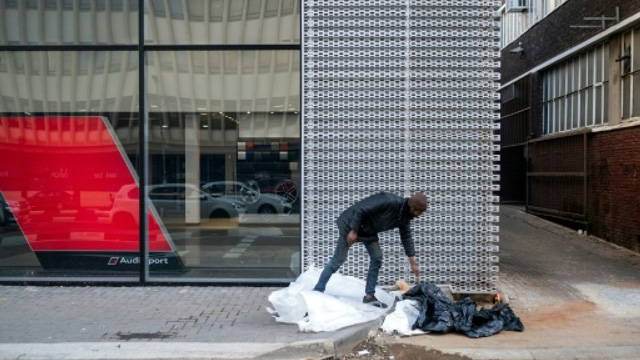
Soweto, South Africa | AFP | After helping an elderly woman load her bags into a mini-bus taxi at a busy intersection in Soweto, a scrawny and strung-out young man is rewarded with a few coins for his efforts.
High on nyaope, a street drug whose main ingredient is heroin, he is determined to make 30 rand ($2) within the next two hours before withdrawal symptoms start to creep in.
“It has been 11 years straight up, just smoking non-stop,” he told AFP as he drew on a cigarette (tobacco) with his trembling hands.
“The thing that made me start smoking nyaope was stress, I had too much stress in my life. So I ended up relying on nyaope to calm me down,” said the frail and distant-eyed 28-year-old.
Heroin has been wreaking havoc in South Africa’s cities and rural areas since the early 2000s, according to a recent report by ENACT, an EU-funded project against cross-border organised crime.
Highly addictive, the nyaope cocktail is made of heroin cut with methamphetamine, codeine and other substances reputedly ranging from anti-retroviral drugs to even powder from flat-screen televisions.
Smoked in a rolled joint laced with marijuana, or else liquidised and injected, it often leaves users with zombie-like sleepiness.
“That is why you find guys at street corners always sleeping.
From the moment when you get the fix, you forget all the problems,” said the nyaope user in Soweto, a township on the outskirts of Johannesburg.
The drug is known as “unga” in the Western Cape, “spices” or “whoonga” in Kwa-Zulu Natal province, and “nyaope” in Gauteng, the province that is home to both Johannesburg and Pretoria.
– ‘Underpinning criminal economy’ –
The ENACT report — “Hiding in Plain Sight: Heroin’s Stealthy Takeover of South Africa” — estimates there are more than 100,000 regular heroin users in South Africa and a trafficking market generating about 3.6 billion rand ($260 million) in annual revenue.
“Heroin is a key commodity underpinning the criminal economy in South Africa, and has facilitated the expansion of the criminal economy,” report author Simone Haysom said.
“The drug trade has had the most destructive effect in poor communities,” she added.
Heroin moves from Afghanistan, which is the world’s top grower of the poppy from which heroin is produced, across the Indian Ocean to east Africa, down through southern Africa and then inland for distribution.
“For 50 metres (yards) around us here, you can buy any drug. It’s a known fact,” Robert Michel, the frustrated director at the non-profit Outreach Foundation, told AFP at their offices in a churchyard in Johannesburg’s Hillbrow district.
Shaun Shelly, founder of the SA Drug Policy Week awareness programme, agreed, saying “as a total stranger you could probably get heroin there in 15 minutes on the street.”
In Hillbrow, one of the most notorious crime-ridden neighbourhoods in downtown Johannesburg, heroin peddling is mostly done by gangs, organised crime syndicates and corrupt police.
“The worst part of it is that the police is not really doing anything. In many cases, what we hear is that the police and the drug dealers are working hand in hand,” Michel said.
– Child addicts –
The scourge has reached many children around age 15, and even some as young as nine, according to Hillbrow social worker Sizwe Bottoman.
“Others have stopped at school as it affects their brain so badly to an extent that they don’t concentrate,” she said.
Last month South African President Cyril Ramaphosa vowed that a “national drug master plan” would reduce demand, cut off supply and “ultimately free our young people from the harm that they cause.”
He said he was alarmed that “the average age of a drug user is getting younger and younger.”
“Drugs such as nyaope… are fuelling violence, crime, suicide and risky sexual behaviour,” the president said.
South Africa’s drug problem is also exacerbated by poor social services and its youth unemployment rate of over 50 percent.
Having previously beaten addiction to crystal methamphetamine and the drug Mandrax, Cape Townian Ashley Abrahams, 38, said he regrets the day he started using heroin 10 years ago.
“It’s not easy to stay clean. You have to be busy, you have to get work,” the homeless man told AFP as he whipped out the teaspoon and lighter he uses to get high.
“Somebody who is on drugs, goes into rehab, comes back onto the streets, and has no prospect of finding a job — and within days gets back into using drugs,” the Outreach Foundation’s Michel said.
“It’s a terrible cycle to break out of.”
 The Independent Uganda: You get the Truth we Pay the Price
The Independent Uganda: You get the Truth we Pay the Price



